
A cigarette is a product consumed via smoking and manufactured out of cured and finely cut tobacco leaves, which are combined with other additives, then rolled or stuffed into a paper-wrapped cylinder (generally less than 120 mm in length and 10 mm in diameter). The cigarette is ignited at one end and allowed to smoulder for the purpose of inhalation of its smoke from the other (usually filtered) end, which is usually inserted in the mouth. They are sometimes smoked with a cigarette holder. The term cigarette, as commonly used, refers to a tobacco cigarette but can apply to similar devices containing other herbs, such as cannabis. They are colloquially known as 'cigs', 'smokes', 'ciggies', 'straights', 'cancer sticks', 'death sticks', 'coffin nails' and 'fags'.[citation needed]
Cigarettes are proven to be highly addictive, as well as a cause of multiple types of cancer, heart disease, respiratory disease, circulatory disease and birth defects.
A cigarette is distinguished from a cigar by its smaller size, use of processed leaf, and white paper wrapping. Cigars are typically composed entirely of whole leaf tobacco.
http://en.wikipedia.org/wiki/Cigarette
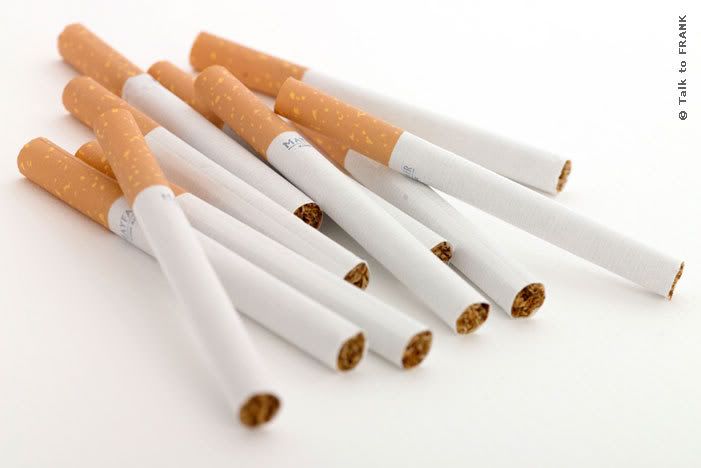
Approximately 5.5 trillion cigarettes are produced globally each year by the tobacco industry, smoked by over 1.1 billion people, which is more than 1/6 of the world's total population.
Smoking Prevalence by Gender
PERCENT SMOKING
REGION MEN WOMEN
Africa 29 4
United States 35 22
Eastern Mediterranean 35 4
Europe 46 26
Southeast Asia 44 4
Western Pacific 60 8
(2000, World Health Organization estimates)
Before the Second World War many manufacturers gave away collectible cards, one in each packet of cigarettes. This practice was discontinued to save paper during the war and was never generally reintroduced, though for a number of years Natural American Spirit cigarettes included "vignette" cards depicting endangered animals and American historical events; this series was discontinued in 2003. On April 1, 1970 President Richard Nixon signed the Public Health Cigarette Smoking Act into law, banning cigarette advertisements on television in the United States starting on January 2, 1971. However some tobacco companies attempted to circumvent the ban by marketing new brands of cigarettes as "little cigars"; examples included Tijuana Smalls, which came out almost immediately after the ban took effect, and Backwoods Smokes, which reached the market in the winter of 1973–1974 and whose ads used the slogan, "How can anything that looks so wild taste so mild."
Beginning on April 1, 1998, the sale of cigarettes and other tobacco products to people under 18 is now prohibited by law in all fifty states of the United States. The legal age of purchase has been additionally raised to 19 in Alabama, Alaska, New Jersey, Utah, and Nassau, Suffolk, and Onondaga Counties in New York.[12] Legislation was pending as of 2004 in some other states, including California to raise the age to 19 or even to 21. In Massachusetts and Virginia, parents and guardians are allowed to give cigarettes to minors, but sales to minors are prohibited.
Similar laws exist in many other countries. In Canada, most of the provinces require smokers to be 19 years of age to purchase cigarettes (except for Quebec, Saskatchewan, Manitoba and Alberta, where the age is 18). However, the minimum age only concerns the purchase of tobacco, not use. Alberta, however, does have a law which prohibits the possession or use of tobacco products by all persons under 18, punishable by a $100 fine. Australia, and Pakistan have a nationwide ban on the selling of all tobacco products to people under the age of 18.
In the UK, cigarettes can legally be sold only to people aged 16 and over. However it is not illegal for people under this age to buy (or attempt to buy) cigarettes, which means that only the retailer is breaking the law by selling to people under the age of 16. From October 2007 in England and Wales, the legal purchase age will rise to 18 — in line with alcohol — in an attempt to increase public health.[13] Scotland and Northern Ireland will probably follow suit. There is also plans drawn up by the Department of Health to ban the sale of the smaller ten-packs in a bid to cut under-aged smoking.
Tabak-Trafik in Vienna. Since January 1, 2007 all cigarette machines in Austria must attempt to verify a customer's age by requiring the insertion of a debit card or mobile phone verification.Most countries in the world have a legal smoking age of 18. Six exceptions are Austria, Belguim, Germany, Portugal, the United Kingdom, and The Netherlands, where the age is 16. Since January 1, 2007 all cigarette machines in public places in Germany must attempt to verify a customers age by requiring the insertion of a debit card. Turkey, which has one of the highest percentage of smokers in its population,[citation needed] has a legal age of 18. Another curiosity is Japan, one of the highest tobacco consuming nations, which requires purchasers to be 20 years of age (Suffrage in Japan is 20 years old.[14]) However, due to the prevalence of cigarette vending machines in the most public of places the effectiveness of an underage ban is in doubt.[citation needed] In other countries, such as Egypt or India (especially Kerala) it is legal to use and purchase tobacco products regardless of age.
Some police departments in the United States occasionally send an underaged teenager into a store where cigarettes are sold, and have the teen attempt to purchase cigarettes, with their own or no ID. If the vendor then completes the sale, the store is issued a fine.[15] Similar enforcement practices are regularly performed by Trading Standards Officers in the UK.
Consumption
Cigarette packs in Australia with graphic health warningsApproximately 5.5 trillion cigarettes are produced globally each year by the tobacco industry, smoked by over 1.1 billion people, which is more than 1/6 of the world's total population.
http://www.answers.com/topic/cigarette?cat=technology
THE TOBACCO TIMELINE
http://www.tobacco.org/History/Tobacco_History.html
Smoking - health risks
http://www.netdoctor.co.uk/health_advice/facts/smokehealth.htm
STATISTICS, FACTS AND FIGURES ABOUT SMOKING
http://ash.org/statistics.html
Childhood Exposure to Second-Hand Smoke Has Long-Lasting Effects: Fruit Fiber May Help
http://www.nih.gov/news/pr/aug2005/niehs-30.htm
Smoking: Facts and Tips for Quitting
http://www.winternet.com/~terrym/quitsmoke.html
Dave Allen - Giving up smoking
Secondhand Smoke Fact Sheet
http://www.lungusa.org/site/pp.asp?c=dvLUK9O0E&b=35422
Second Hand Smoke PSA
Overall Stats and Youth Smoking Facts
http://quitsmoking.about.com/cs/antismoking/a/statistics.htm
Worldwide, between 80,000 and 100,000 kids start smoking every day. Approximately one quarter of children alive in the Western Pacific Region* will die from smoking.
The World Health Organization (WHO) has compiled worldwide smoking statistics for the year 2002. The smoking facts and stats presented are sobering.
About a third of the male adult global population smokes.
Smoking related-diseases kill one in 10 adults globally, or cause four million deaths. By 2030, if current trends continue, smoking will kill one in six people.
Every eight seconds, someone dies from tobacco use.
Smoking is on the rise in the developing world but falling in developed nations. Among Americans, smoking rates shrunk by nearly half in three decades (from the mid-1960s to mid-1990s), falling to 23% of adults by 1997. In the developing world, tobacco consumption is rising by 3.4% per year.
About 15 billion cigarettes are sold daily - or 10 million every minute.
About 12 times more British people have died from smoking than from World War II.
Cigarettes cause more than one in five American deaths.
Among WHO Regions, the Western Pacific Region - which covers East Asia and the Pacific - has the highest smoking rate, with nearly two-thirds of men smoking.
About one in three cigarettes are consumed in the Western Pacific Region.
The tobacco market is controlled by just a few corporations - namely American, British and Japanese multinational conglomerates.
Youth
Among young teens (aged 13 to 15), about one in five smokes worldwide.
Between 80,000 and 100,000 children worldwide start smoking every day - roughly half of whom live in Asia.
Evidence shows that around 50% of those who start smoking in adolescent years go on to smoke for 15 to 20 years.
Peer-reviewed studies show teenagers are heavily influenced by tobacco advertising.
About a quarter of youth alive in the Western Pacific Region will die from smoking.
Health and Advertising
Health
Half of long-term smokers will die from tobacco. Every cigarette smoked cuts at least five minutes of life on average - about the time taken to smoke it.
Smoking is the single largest preventable cause of disease and premature death. It is a prime factor in heart disease, stroke and chronic lung disease. It can cause cancer of the lungs, larynx, oesophagus, mouth, and bladder, and contributes to cancer of the cervix, pancreas, and kidneys.
More than 4,000 toxic or carcinogenic chemicals have been found in tobacco smoke.
One British survey found that nearly 99% of women did not know of the link between smoking and cervical cancer.
One survey found that 60% of Chinese adults did not know that smoking can cause lung cancer while 96% were unaware it can cause heart disease.
At least a quarter of all deaths from heart diseases and about three-quarters of world's chronic bronchitis are related to smoking.
Smoking-related diseases cost the United States more than $150 billion a year.
Advertising
US-based multinational Philip Morris - the world's biggest cigarette company - was the world’s ninth largest advertiser in 1996, spending more than $3 billion.
A survey a few years ago found that nearly 80% of American advertising executives from top agencies believed cigarette advertising does make smoking more appealing or socially acceptable to children. Through advertising, tobacco firms try to link smoking with athletic prowess, sexual attractiveness, success, adult sophistication, adventure and self-fulfilment.
A survey in the UK found about half of smokers think that smoking "can’t really be all that dangerous, or the Government wouldn’t let cigarettes be advertised".
A 1998 survey found that tobacco companies were among the top 10 advertisers in 18 out of 66 countries surveyed.
In Asia, tobacco companies are among the top 10 advertisers in Cambodia, Indonesia, Malaysia, Myanmar and the Philippines.
In Russia, according to press reports, foreign tobacco companies are the largest advertisers, accounting for as much as 40% of all TV and radio advertising.
In 1997, the tobacco industry's spending on advertising in the United States was about $15 million a day ($5.7 billion for the year).
The tobacco industry has changed the way it advertises in the last 30 years. Now, only 10% of advertising expenditure goes to print and outdoor advertisements, while more than half goes to promotional allowances and items, such as t-shirts for young people or lighters and key rings.
After the entry of foreign multinational tobacco firms into Japan, the Republic of Korea and Thailand, youth and female smoking rose significantly.
*The 37 countries and areas comprising the WHO Western Pacific Region are: American Samoa, Australia, Brunei Darussalam, Cambodia, China, Cook Islands, Fiji, French Polynesia, Guam, Hong Kong (China), Japan, Kiribati, Lao People's Democratic Republic, Macao (China), Malaysia, Marshall Islands, Federated States of Micronesia, Mongolia, Nauru, New Caledonia, New Zealand, Niue, Northern Mariana Islands, Palau, Papua New Guinea, Philippines, Pitcairn Islands, Republic of Korea, Samoa, Singapore, Solomon Islands, Tokelau, Tonga, Tuvalu, Vanuatu, Viet Nam, and Wallis and Futuna.

Smoking Facts
http://www.quitguide.com/smoking-facts.html
Laugh or cry these smoking statistics are real, and enough to make you scratch your head in wonderment at the quirkiness of the human race.
We all steer ourselves through life in different ways, and it should be nobody else's concern what we choose to do, as long as it doesn't harm others, and as long as we accept the consequences of our actions and are willing to pay for them.
Society is set up to protect us and others by constraints, advice and laws, but since time began people will still do what they want to do... often with unfortunate or utterly catastrophic results.
Our world's smoking facts... from rolling in the hay to pushing up daisies:
Pregnancy and babies
In U.S. alone, figures show that expectant mothers who smoke cause the deaths of over 600 boy babies and 400 baby girls each year. Babies who survive but suffer from smoking related problems cost the country approximately $800 each to help, totaling nearly $4 million.(3)
Children
A UK survey shows the mean age for young people to try their first cigarette is 11 years old.
Teens
U.K. By age 12-13years, 31% of kids had tried smoking. This doubled to 59% by age 14-15.
Adults
Many smokers get angry once they are diagnosed with a life-threatening disease and they do some extraordinary things:
Take Barb Tarbox from Edmonton, UK - ex-model, died of lung cancer aged 42 in 2003.
She spent the last 7 months of her life parading her slowly emaciating body and bald head due to radiation, around schools, TV spots, print ads and anywhere she could get the message across to try and stop, "even one child from picking up a cigarette," she said.
She made people cry at her appearances especially near the end when she couldn't walk or feed herself and had to be wheelchaired into halls to passionately speak.
She left a 10 year old daughter and husband of 20 years – and a lot of smokers there and then threw away their cigarettes.
AUSTRALIA
Smoking statistics for 2005 show that 17% of Australians smoke. In 1993 this figure was higher at 25%.
Other drugs: Ecstasy has become popular and figures have risen in recent years. Other drugs have declined in use. Marijuana is tried by 11 % of Australians.(8)
NSW is the most populated state with 6 million people, and around 18% of the adults are smokers.
This means a social and health burden to NSW taxpayers, families and businesses of $6.6 billion per year.
In the latest figures, 6860 deaths were attributable to smoking and 353,180 hospital bed days were for people suffering tobacco-related illness, at a cost of $254 million.
Of the total tangible costs of smoking, 58 per cent were borne by individuals, 29 per cent by business and only 13 per cent by governments.(4)
150 smokers end up in hospital each day because of their habit.(5)
NSW spent $7 million each year on prevention programs.(6)
CHINA
The facts about smoking in China are scary and getting scarier by the minute:
It produces more tobacco than any other country.
It has an estimated 350 million smokers – that's 1 in 3 of the world's smokers.
36% of the population smoke, including 70% of all Chinese men. Most of them have no knowledge of the facts about smoking or any awareness of the consequences they face.
More than one million people a year die in China from tobacco-related diseases, including lung cancer and heart disease.
These 1 million smokers were mainly aged 35-69 and this figure is predicted to increase to 2 mil in just 15 years.
In fact the biggest killer in China in 2005 was lung cancer, beating road accidents (and if you drive in China, you'll know what this means!).(2)
CUBA – home of smooth cigars and black tobacco cigarettes:
In an effort to have Cubans live longer, Fidel Castro issued a stop smoking resolution back in Feb 2005, banning smoking in enclosed public spaces, such as halls, theatres, sports facilities, transport, and designated areas in clubs and restaurants. Cubans laughed at the idea and mostly ignored this attack on their sacred vice, and the authorities are not interested in enforcing the ban.
Castro himself quit chomping on cigars in 1986 to try and set a good example to other Cubans and to support his health ministry's anti-smoking efforts.
Cubans took no notice and currently 40% of the population of 11.2 million smoke.
The cheapest pack of cigs costs ½ a day's pay and one cheap cigar costs ¼ of a day's pay.
Smoking death statistics for Cubans, that cancer and heart disease are the leading causes of death, with the highest percentage caused by smoking.
Doctors are some of the heaviest smokers even though they were banned from smoking during work back in 1990.
ENGLAND & WALES
45,000 people die each year from COPD (chronic bronchitis and emphysema), or diseases precipitated by COPD, such as pneumonia, heart disease and stroke. Smoking is the leading cause of COPD. A smoker is 10 times more likely to die of COPD than a non-smoker. Global deaths are estimated to be 4.8 million.(7)
UNITED STATES
The Centers for Disease Control and Prevention publish interesting smoking facts. Here are some 2005 smoking statistics:
Approximately 20.9% (44.5 million) adults currently smoke. Of these, 81.3% (36.1 million) smoke every day, and 18.7% (8.3 million) smoke some days. Among those who currently smoke every day, 40.5% (14.6 million) report that they had stopped smoking for at least 1 day during the preceding 12 months because they were trying to quit. Among the estimated 42.4% (90.2 million) of persons who had ever smoked, 50.6% (45.6 million) were former smokers.(3)
More interesting smoking facts about population sub-groups in the US:
Education: The highest group of smokers are those with the basic General Educational Development diploma (GED) – 40%, and 35% people with a 9th–11th grade education smoked, and smoking prevalence kept decreasing with increasing years of education. The lowest percentage of smokers was among those with graduate degrees at 7.5%.
Gender: Current smoking was higher among men (23.4%) than women (18.5%).
Race Among racial/ethnic populations, Asians (11.3%) and Hispanics (15.0%) had the lowest prevalence of current smoking. American Indians/Alaska Natives had the highest prevalence (33.4%), followed by non-Hispanic whites (22.2%) and non-Hispanic blacks (20.2%).
General: Overall, the lowest smoking prevalence rates were in certain subpopulations and included women with undergraduate (11.0%) or graduate degrees (6.7%), men with graduate degrees (8.1%), Hispanic women (10.3%), Asian women (6.5%), and men and women over 65 years (10.1% and 8.3%, respectively).
Income: Current smoking prevalence was higher among adults living below the poverty level (29.1%) than among those at or above the poverty level (20.6%).
Usage: Heavy smokers, i.e. more than 25 cigarettes per day averaged 12.1%. The mean number of cigarettes smoked per day among daily smokers was 16.8 (18.1 cpd for men and 15.3 cpd for women). More than 20 billion packs of cigarettes are sold per year.
Costs: For every packet of cigarettes smoked, add US$8.00 that society pays for medical and lost productivity costs. Thus the economic costs of smoking total approximately $3780 per smoker per year. This equates to over $160 billion in smoking health-related costs.
Age: Among age groups, persons over 65 years had the lowest prevalence of cigarette smoking (9.1%); persons aged 18–24 came in at 23.9%; and persons aged 25-44 years had the highest prevalence (25.6%).
Smoking deaths: Smoking kills approximately half a million people per year in U.S. Most of them die of lung cancer, heart disease or emphysema. Of these an estimated 10% are people who die of disease due to secondhand smoke. 46% more men are killed by smoking than women.
GLOBAL
Facts about smoking deaths
Smoking tops the list of premature deaths and disease in every country.
World smoking facts
In the industrialized world in 2005, Australia has the fewest smokers – 17% of those over 15 light up. The highest incidence is in Holland (34%), with Hungary next (33%) and Korea third (30%).(8)
Smoking Holocaust
Deaths caused by tobacco during a 5 year period are roughly 15 million.
The Jewish Holocaust lasted 5 years and claimed 6 million lives.
Producing tobacco products designed to kill more than 50% of their users is legal.
Users of tobacco products choose to make a deliberate 50% gamble to kill themselves.
Deliberate killing, even due to war is illegal and results in the death penalty or imprisonment for the murderers.
Smoking statistics on higher tobacco taxes
It is a myth that raising the tax levied on tobacco products will produce a corresponding drop in consumption. There is usually a small drop to begin with but then no matter how high prices are raised, the demand by smokers becomes insensitive to the price after a while. Not only that, but the "black market" flourishes with suppliers of "tax-free" products.
Tobacco
Cigarette smoke contains over 3,000 chemicals: Most of them are rather nasty such as:
Nicotine - insecticide and used in cockroach and other insect killing products
Formaldehyde – used as a fluid to embalm dead bodies
Hydrogen cyanide – rat poison
Acetone – dissolves certain substances and commonly found in nail polish removers
Hydrazine – used in rocket fuel
Disease
Smokers have less vitamin C than non-smokers.
Although this has consistently been proved, researchers don't know why. Smokers 30% average depletion of vit C is either due to the fact that smokers generally eat a less healthy diet, or smoking stops vitamin C from being metabolized.
Work
Lost productivity: Smokers spend an average of 18 days a year on smoke breaks.
Companies spend about 40 percent more on employer-paid health-care insurance for tobacco users.
Tobacco Companies
Tobacco is unregulated. Tobacco companies are allowed to put whatever they like into their products. Where they have caused ire is where they have lied about the ingredients and quantities.
In June 2001 the largest judgment ever made for an individual was to cancer-stricken smoker, Richard Boeken in the US who began smoking as a teenager in 1964. The Los Angeles court ordered Philip Morris to pay $3 billion to Boeken in punitive damages and $5.5 million in general damages.
From 1935 onwards, scientist seriously began to amass undeniable evidence on the health risks of smoking and the US Congress slapped the surgeon general's warning label on cigarette packs in 1965.
Pollution Smoking Facts
Before smoking bans, which is more harmful - diesel and exhaust fumes or a smoky pub? You got it... enclosed smoky spaces such as bars and casinos have up to 50 times more cancer-causing particles in the air than roads.
For tests, special detectors measured for two of the worst groups of chemicals:
1. Particulate polycyclic aromatic hydrocarbons, or PPAHs. Indoor readings averaged 134 nanograms per cubic meter – 5 times higher than even rush hour and heavily polluted highways which came in as levels from 7 to 18 nanograms.
2. Respirable particles — airborne soot small enough to penetrate the lungs. Indoor levels averaged 231 micrograms per cubic meter of air – 15 times the United States EPA safety limit, and 49 times rush hour traffic. Even in the crowded Baltimore Harbor Tunnel, 199 micrograms was the top reading.
After the smoking ban took effect, levels of both cancer-causing substances dropped 90% or more in all of the indoor places tested, with the air quality nearly indistinguishable from outside air.
Penn & Teller Second Hand Smoke Correction

A safer smoke?
Legislation would allow FDA to regulate tar, nicotine and other chemicals in cigarettes
http://www.thestate.com/nation/story/120511.html
A safer smoke?
Legislation would allow FDA to regulate tar, nicotine and other chemicals in cigarettes
WASHINGTON — The federal agency charged with keeping food and drugs from harming people soon might be asked to take a consumer product that kills more than 400,000 people a year and make it safer.
The product is the cigarette — generally acknowledged as anything but safe. Smoking accounts for nearly one in five deaths in the United States.
That toll can be reduced, tobacco foes say, and they point to a bill expected to pass a Senate committee Wednesday as the tool to make it happen.
The legislation would give the Food and Drug Administration the same authority over cigarettes and other tobacco products the regulatory agency already has over countless other consumer products.
It’s not something the agency necessarily wants, according to past comments by FDA commissioner Dr. Andrew von Eschenbach.
The bill (S.625) would let the FDA regulate the levels of tar, nicotine and other harmful components of tobacco products. Cigarette smoke alone contains nearly 4,000 chemicals, more than 40 of which are known to cause cancer.
“Are we going to cut cancer in half with FDA control? No. Can we do with cigarettes things that are important in regulating a product to minimize its toxicity? Yes, I think we can,” said Dr. David Burns of the University of California, San Diego, scientific editor of several surgeon general reports on tobacco.
New products would need FDA approval before they could be sold. The bill also would authorize the FDA to set national standards for tobacco products to control how they are made and force the disclosure of their ingredients. That, supporters claim, should help expose — and ultimately limit — the ways cigarettes are engineered to the detriment of the public’s health.
The bill could let the FDA “require changes in tobacco products ... that will reduce the harmfulness of the products or the addictiveness of the products,” said Matthew Myers, president of the Campaign for Tobacco-Free Kids.
No one thinks the Senate bill, which has matching legislation in the House, could result in a safe cigarette. But some foes of the bill maintain it could create that impression.
“The problem is the public is going to perceive the product is safe because the FDA has assumed jurisdiction,” said Dr. Michael Siegel, a Boston University School of Public Health professor.
Advocates say the bill at least would let the FDA look at scientific evidence and use that as the basis for its decisions.
The bill also would keep tobacco companies from tinkering with their products in ways that would make them more dangerous or addictive, supporters say.
When asked for some likely targets regulators could tackle, Centers for Disease Control and Prevention chemist David Ashley rattled off more than six compounds in tobacco and smoke that worry scientists, including:
• Nitrosamines, a potent carcinogen. The burley tobacco used in American cigarettes is especially high in nitrosamines.
• Acetaldehyde, a potential carcinogen that might make tobacco more addictive. It’s produced when sugars, added to tobacco, are burned.
• Cadmium and lead, two heavy metals that are toxic. Their levels generally depend on the environmental conditions where the tobacco is grown.
But Ashley, an expert in the constituents of tobacco and tobacco smoke, cautions that cigarettes are complex and have changed over time.
“One problem from a scientific standpoint is the product changes so often, but the health effects are long-term. The cigarettes people are smoking today aren’t the cigarettes of 10 years ago,” Ashley said. “It’s hard to link a change in the products to a particular health endpoint, because there’s nothing you can get your hands around.”
Nor would it appear that, under the legislation, the agency could approve any new cigarette, even if it purportedly were safer, said Sen. Richard Burr, R-N.C., who opposes the bill.
“It’s an impossible pathway to understand at an agency tasked with a mission that is to prove safety and efficacy,” said Burr, contending such an arrangement could keep any new reduced-harm tobacco product from coming on the market.
Philip Morris USA, maker of Marlboro, the nation’s top-selling cigarette brand, supports the bill. R.J. Reynolds Tobacco Co. and others oppose the legislation, saying its restrictions on advertising would help cement Philip Morris’ No. 1 market position.

Tobacco Bill Includes Compromise and Criticism
http://www.nytimes.com/2007/07/17/health/17tobacco.html
WASHINGTON, July 16 — As legislative changes go, the switch allowing cloves to be added to cigarettes instead of being banned was a relatively small one in a landmark bill to regulate tobacco products, but the bill’s detractors say it is symbolic of the bill’s unacceptable compromises.
The Senate health committee is scheduled on Wednesday to consider a bill that would for the first time allow the Food and Drug Administration to regulate cigarettes. The bill now has 52 sponsors in the Senate, and a top House Republican predicted it would pass there by 2 to 1.
Health advocates are predicting that, after more than a decade of debate, this may be the year tobacco regulation is made law. But many are holding their noses at some of the bill’s provisions, like the shift on cloves.
A version of the legislation released in February included cloves in a list of artificial or natural flavors like strawberry, chocolate and cocoa that would be banned from cigarettes largely because they had been used to appeal to children.
Last week, Senator Edward M. Kennedy, Democrat of Massachusetts, the chairman of the health committee and the principal author of the legislation, released the latest version of the bill. In it, cloves joined menthol as the only additives specifically allowed in tobacco.
The main beneficiary of the change seems to be Philip Morris, the nation’s largest cigarette manufacturer, which recently introduced a clove-flavored version of its Marlboro brand in Indonesia. The company spent $5 billion in 2005 to buy a controlling stake in Sampoerna of Indonesia, a large maker of clove cigarettes.
Philip Morris, a division of Altria, has become a crucial ally for the bill, splitting what had been united industry opposition to regulation. Carol Springstun, a company spokeswoman, said it had no plans to import clove cigarettes into the United States.
The American Lung Association and other health advocates said they were disappointed by the change in the bill but still supported it.
“We would prefer that the bill continue to prohibit clove-flavored cigarettes,” said Paul G. Billings, a spokesman for the American Lung Association. “But Senator Kennedy is trying to craft a path that can move the legislation through to final passage.”
Other public health experts were more dismayed. “This industry doesn’t miss a trick, and anything that Philip Morris wants can’t be good,” said Dr. Richard Hurt, director of the nicotine dependence program at the Mayo Clinic.
Mr. Kennedy was contacted by at least six Senate offices after the Indonesian government wrote a letter opposing the ban and suggesting it might violate trade laws. After that, the clove exception was born.
“Concerns were raised that the provision violated trade laws since it prohibited clove cigarettes, which are exclusively imported from Indonesia, but treated menthol, a domestic product, less restrictively,” said Melissa Wagoner, a spokeswoman for Mr. Kennedy.
To Senator Michael B. Enzi, Republican of Wyoming, the change is emblematic of the underlying flaw in the legislation. Mr. Enzi points out that, under the legislation, Congress is asking the drug administration, one of the world’s premier health agencies, to regulate a product that kills more than 400,000 people each year in the United States.
“Poison peddlers shouldn’t get to decide how we as responsible legislators fight the war against their deadly products,” he said.
There are no national estimates about the prevalence of clove cigarette smoking, but the Centers for Disease Control and Prevention estimates that up to 3 percent of high school students and 2 percent of middle school students smoke clove cigarettes, also known as kreteks.
The drug agency is a bit uncertain about whether it wants to regulate cigarettes. In public testimony recently, Andrew von Eschenbach, the commissioner of food and drugs, said he would not want his agency to have to decide whether a cigarette was safe. The bill would give the agency up to $450 million annually from a tax on tobacco to hire the staff needed to regulate the industry.
In 2004, President Bush said he opposed an earlier version of the tobacco legislation, but he has yet to make a public statement about the latest proposal. A White House spokesman did not offer a comment Monday.
The bill would give the drug agency the power to regulate all tobacco advertisements and ban any that were intended to attract children and teenagers. The agency would police any claims, stated or implied, that some cigarettes were healthier than others.
The legislation would also prevent tobacco companies from tinkering with cigarette ingredients without F.D.A. approval. That is intended to stop the industry from increasing the addictiveness of cigarettes.
Some cigarette makers say the bill favors Philip Morris because the bill’s strict regulation of tobacco advertisements and new products will make it all but impossible to unseat the company from its dominant position.
“We believe the legislation being considered would put us at a competitive disadvantage in that we would not have the ability to communicate product differences with adult tobacco consumers,” said David Howard, a spokesman for the R. J. Reynolds Tobacco Company.
Dr. Gregory N. Connolly, a professor at the Harvard School of Public Health, said cloves and menthol had similar effects. Both make cigarette smoke seem cooler and smoother, which is crucial for luring younger smokers into becoming addicted, Dr. Connolly said. Both are also popular mostly among nonwhites, he said.
Still, Dr. David A. Kessler, the former F.D.A. commissioner whose efforts to regulate tobacco without specific Congressional legislation were struck down by the Supreme Court, said the cloves compromise, like others in the bill, was acceptable.
“There is a clear consensus now that more lives will be saved by this legislation than not,” Dr. Kessler said

Most back FDA tobacco regulation
http://www.upi.com/Health_Business/Briefing/2007/07/16/poll_most_back_fda_tobacco_regulation/9508/
WASHINGTON, July 16 (UPI) -- Most Americans think the U.S. Food and Drug Administration should be granted authority over tobacco, according to a poll released Monday.
A Senate committee is set to vote on the issue Wednesday.
The survey of 800 registered voters -- done by Public Opinion Strategies and the Mellman Group -- found that 70 percent of voters support Congress passing the legislation and 72 percent view the bill's passage as an "important accomplishment."
In fact even a "majority of smokers" support the bill, said advocacy group Campaign for Tobacco-Free Kids, and support for the measure seems to cut across ideological lines, with 72 percent of Republicans, 71 percent of Democrats and 68 percent of Independents favoring FDA regulation of tobacco.
"There are few issues before Congress on which you'd find such strong consensus across regions and across party lines," said Matthew Myers, president of the Campaign for Tobacco-Free Kids. "Americans agree that it's time for Congress to address the nation's number one preventable cause of death and end the deadly status quo that allows tobacco companies to target our children and mislead the public."
However, policy experts have warned that, if the FDA were given authority over tobacco products, including cigarettes, it would have to ban them outright as harmful drugs and/or devices, as the agency is bound by law to approve only those products under its purview that it finds to be "safe and effective."
Specific findings from the survey include:
-- 80 percent support restricting tobacco sales to children by requiring ID checks for younger buyers and fining retailers who sell tobacco to minors.
-- 76 percent support restricting tobacco marketing aimed at children such as limiting advertising in magazines with a large percentage of readers under age 18.
-- 68 percent support preventing tobacco companies from making claims that some products are less harmful than others unless the FDA determines those claims are true.
Timeline: Smoking and disease
http://news.bbc.co.uk/1/hi/health/3829607.stm
BBC News Online traces key developments in the half a century since researchers began their landmark investigation into links between smoking and life-threatening diseases.
1951: Dr Richard Doll and Prof Austin Bradford Hill conduct first large-scale study of link between smoking and lung cancer.
1954: Dr Doll and his team publish a paper confirming the link.
1957: British Medical Research Council announces "a direct causal connection" between smoking and lung cancer.
1962: Royal College of Physicians report concludes that smoking is a cause of lung cancer and bronchitis, and probably contributes to coronary heart disease. It recommends tougher laws on cigarette sales and advertising, and smoking in public places.
1965: British government bans cigarette advertising on television.
1971: Government health warnings to be carried on all cigarette packets sold in the UK, following an agreement between the government and the tobacco industry.
1973: First tar/nicotine tables published in UK.
1974: Tar tables upgraded, dividing cigarettes into five categories of tar content.
1975: Imperial Tobacco agrees to drop brand names and logos from racing cars in UK races as control of tobacco advertising switches from the industry to the independent Advertising Standards Authority.
1976: Prof Sir Richard Doll and Richard Peto publish results of 20-year study of smokers, and conclude that one in three dies from the habit.
1983: Latest Royal College of Physicians report features passive smoking for the first time. It also asserts that more than 100,000 people die every year in the UK from smoking-related illness.
1984: Smoking banned on London Underground trains.
1985: Smoking ban extended to those stations that are wholly or partly underground.
1986: New advertising and promotion guidelines agreed, including banning tobacco advertising in cinemas and a range of new health warnings.
1987: London Underground smoking ban extended to entire network following the King's Cross station fire, in which 31 people died.
1988: Independent Scientific Committee on Smoking and Health report concludes that non-smokers have a 10-30% higher risk of developing lung cancer if exposed to other people's smoke.
June 1988: A US court awards damages against a tobacco firm to the family of a woman who died of lung cancer.
1989: A UK court rules that injury caused by passive smoking can be an industrial accident.
1992: First nicotine skin patch available on prescription in the UK.
1993: Sir Richard Doll's latest study results suggest smokers are three times more likely to die in middle-age than non-smokers, and up to half of all smokers may eventually die from their habit.
1996: A lung-cancer sufferer awarded $500,000 against a US tobacco company after a jury ruled that the manufacturer had shown negligence in not alerting smokers to the hazards of smoking.
May 1997: New Labour government pledges to ban tobacco advertising.
June 1997: US tobacco firms agree a multi-billion-dollar settlement to cover healthcare costs incurred by treating people with smoking-related illnesses in return for halting multi-action lawsuits and limiting claims for individuals.
1997: Government calls for Formula One to be exempt from proposed EU directive on tobacco advertising and sponsorship, but backs down in the face of widespread criticism which threatens the entire directive.
March 1998: Government-appointed Scientific Committee on Tobacco and Health says passive smoking is a cause of lung cancer and heart disease in adults.
February 1999: Court in California orders Philip Morris to pay $50m damages to a smoker with lung cancer. Award later halved.
March 2000: Another award against Philip Morris and RJ Reynolds becomes a landmark because the plaintiff had begun smoking after health warnings had started appearing on cigarette packets.
2001: New EU directive requires larger, more prominent health warnings on tobacco packaging.
2002: British parliament passes legislation that began as a Private Member's Bill, banning tobacco advertising. Deadline for phasing out sponsorship of Formula One motor racing brought forward to comply with EU directive.
December 2002: British Medical Association calls for a ban in smoking in public places because of the threat to non-smokers.
2003: Cancer Research UK advertising campaign, funded by the Department of Health, targets smokers of mild brands, warning that they could be just as dangerous.
January 2004: British Heart Foundation uses graphic images to reinforce its government-sponsored anti-smoking campaign.
March 2004: The Irish Republic introduce the toughest anti-smoking laws in Europe with a complete ban in workplaces. Taoiseach Bertie Ahern described it as "landmark legislation".
November 2004: A Public Health White Paper proposes introducing a smoking ban in workplaces by 2008, with pubs which do not serve food and private members clubs exempted. The legislation would apply to England and Wales, but the Welsh Assembly has said it would amend the bill to create a comprehensive ban when it gains Royal Assent in England.
March 2005: A British Medical Journal report produces the most authoritative data yet on the impact of passive smoking. Researchers claimed it killed 11,000 a year in the UK.
April 2005: MSPs voted by 83 to 15 to introduce a ban on smoking in public places from April the following year. Smokers who defy the ban are liable to pay a £1,000 fine.
September 2005 - Eye experts warn smokers are twice as likely to lose their sight in later life than non-smokers.
October 2005: Northern Ireland agree on a smoking ban in all workplaces and public spaces from April 2007 as discussions over the England smoking ban break down at cabinet level, causing the smoking ban bill to be delayed and doubts over how a ban will be introduced.
The Statistics on Smoking
http://www.dummies.com/WileyCDA/DummiesArticle/id-2233.html
Tobacco has been in use for at least several hundred years, although the cigarette did not become mass-produced until the nineteenth century. Cigarette consumption since then has taken off like wildfire. Current estimates are that over 1 billion people in the world smoke. (In other words, approximately one in three adults on the planet smokes.) The majority of these smokers reside in countries on the low end to the middle of the socioeconomic spectrum. Of this majority, about 80 percent live in low- and middle-income countries. The total number of smokers worldwide is expected to keep increasing.
Although all forms of tobacco can cause disease given frequent enough use and/or susceptibility on the part of user, some forms of tobacco are more toxic than others. While chewing tobacco and smoking pipes were fairly popular in the past, by far most tobacco is now used in the form of cigarettes, either manufactured or hand-rolled. Bidis, another form of rolled tobacco, are widely used in India and in parts of southeast Asia. Bidis are increasingly popular among students in the United States.
Smoking around the world
Cigarette use in nations with low or midrange incomes has been increasing for more than 30 years. At the same time, a general reduction of smoking among men in high-income countries has occurred. The other side of the statistical coin is that, as a group, women and teenagers are smoking more than they used to.
The World Health Organization has been studying smoking trends and statistical patterns across the globe and has found the following to be true:
A good deal of variation exists from one part of the world to another. Many more women smoke in Eastern Europe than in East Asia and the Pacific Region. Eastern Europe itself has a particularly high rate of smoking, with up to 59 percent of adult males smoking.
As with other substances of abuse, such as alcohol and cocaine, the global frequency of tobacco use varies by social class, historical era, and culture. Historically, smoking had been a pastime of the rich. This trend has changed dramatically in recent decades. It appears that economically advantaged men in wealthier countries have been smoking less. The more years of education you've had, the less likely you are to be a smoker.
Most smokers begin early in life, before they are 25 years old. According to World Health Organization studies, the majority of smokers in affluent countries begin in their teens. A decline in the age of starting smoking has been observed worldwide.
As a wannabe quitter, you're in excellent company. People all over the world are trying to quit and stay away from smokes. There appears to be a correlation between a country's standard of living, level of education, and income and the number of people who have quit smoking. The more and better-informed people are, the more likely they are to quit smoking.
The World Health Organization met in Geneva in February 2003 to finalize the wording of a treaty to control tobacco and its almost immeasurable effects on global health. The treaty is intended to reduce cigarette advertising, forbid false and misleading information from being passed along to consumers, encourage higher taxes, and promote the tobacco industry's responsibility and liability for its goods. Proponents of international smoking reduction would like to see a global ban on cigarette advertising and sponsorships of sporting events by tobacco companies. Britain recently enacted a nationwide ban on all tobacco advertising. Ireland will ban smoking in all workplaces, including bars and pubs, starting in 2004. A far-reaching ban on public smoking has already been enacted in Thailand, with observers reporting that, for the most part, the law seems to be upheld.
The U.S. smoking scene
Following 20 years of declining smoking rates in the United States, the percentage of people who smoke has reached a steady plateau of about 25 percent. In other words, smoking rates have stopped declining. Numerous statistical studies have shown that an inverse correlation exists between the price of tobacco and the number of people who smoke. In the 1970s, when cigarette prices in England fell, the number of smokers increased. In the 20 years that smoking in the U.S. decreased, cigarette prices steadily rose.
Recent estimates of the annual cost to the United States in smoking-related healthcare and lost workdays are at least $100 billion a year. Yes, you read that right: $100 billion. And tobacco's impact goes far beyond lost workdays. If you are a regular or heavy smoker, you spend significant amounts of time finding ways to get out of the office to light up. Your focus and energy are diluted by the near-constant necessity to calculate, to strategize, to sneak in those out-of-office smokes. Some people's attitudes about their work are quite casual, and they may feel that they're simply punching in and punching out to earn a wage. But you may not be one of those people. To the extent that you are focused on your work and that what you do really matters to you — and you believe in your heart that your work makes a difference to others — you must regret the time and energy that go into the pursuit of smokes.
Despite all the clamor from the Surgeon General, health authorities, antismoking activists, and those who have suffered physical illness as a result of smoking, almost one in four adults in the United States still smokes. Up to half of smokers try to quit during any given year.
There's plenty of good news in the United States regarding quitting smoking, too. Recent years of legislation represent a virtual monsoon outlawing smoking in public places like restaurants, transportation centers, and municipal offices. Educational efforts aimed at young people and other groups who are demographically poised to begin smoking have been effective. The hope is that the United States will pour more public funds (including those garnered from tobacco company lawsuits) into preventive and educational efforts. Already, there are volumes of news clippings related to events on the local and national level to stop smoking.

Smoking curbs: The global picture
The BBC News Website traces the recent wave of smoking bans around the world as governments seek to improve the health of their populations.
http://news.bbc.co.uk/1/hi/world/3758707.stm
AUSTRALIA
Smoking was banned on Manly, one of Australia's most famous and picturesque stretches of surfing beach, in May 2004.
Other Sydney areas - including the world-famous Bondi Beach - are reported to be considering following suit.
Smoking is already banned in all airports, government offices, health clinics and workplaces in Australia. Restaurants and shopping centres in most states and territories are also smoke-free zones.
BHUTAN
The sale of tobacco products has been banned throughout the Himalayan kingdom of Bhutan.
It is believed to be the first country to have done this.
The move is part of the government's strategy for predominantly Buddhist Bhutan to eventually become a smoke-free nation.
Smoking was only popular with a small percentage of the Bhutanese population, correspondents say. Chewing tobacco was much more common.
CANADA
Smoking levels are some of the lowest in the world, with some 21% of Canadians over the age of 15 reported smoking in 2002, according to government statistics.
Public health experts say the decline has been driven by tough anti-smoking measures adopted in recent years.
In addition to bans on smoking in workplaces and many public places, cigarette packets bear graphic images of the damage done to internal organs by smoking.
CUBA
Smoking was banned on public transport, in shops and other closed spaces from 7 February, 2005.
The authorities are seeking to curb damage to people's health and help bring about a change in public attitudes.
More than half of Cuban adults are thought to smoke, and 30% of preventable cancer deaths are said to be linked to smoking.
Cuban leader Fidel Castro - a cigar aficionado in the early days of his left-wing revolution - kicked the habit in 1986 for health reasons.
EUROPE
Estonia joined those European countries banning smoking in bars and restaurants on 5 June, 2007. The law bans smoking in cafes, restaurants, bars, nightclubs, except for special zones, and at bus stops and underground train stations. Offenders face a fine of 80 euros, while owners of cafes and restaurants can face a fine of up to 2,000 euros.
Finland introduced a similar measure on 1 June.
France took a major step towards a total public ban when it announced it would prevent smoking in workplaces and other public buildings from 1 February 2007.
It also heralded plans to expand the curbs in 2008 to include cafes, restaurants and bars.
Its first serious move to cut smoking levels came in October 2003, when it raised the price of cigarettes by 20%.
The move provoked a strike from furious tobacconists, many fearing being forced out of business by smokers crossing borders to buy cigarettes in neighbouring countries.
Analysts said the plan was driven by government concern that smoking levels were not declining fast enough in France, and a need to fill an $8.5bn shortfall in the country's health budget.
Despite the price hike, correspondents reported no noticeable difference in Paris' traditionally smoke-filled cafes and bars.
The new moves were seen by many as an inevitable consequence.
Ireland imposed tough anti-smoking legislation in March 2004, banning smoking in pubs, restaurants and other enclosed workplaces.
Anyone caught smoking in a prohibited location now faces a fine of up to 3,000 euros (£2,000).
Despite fears the ban would be widely flouted, BBC correspondent James Helm reported most smokers in pubs adopting a pragmatic view and popping outside to the street or beer garden for a puff between pints.
Italy imposed a ban on smoking in all enclosed public places including bars and restaurants from midnight on 10 January, 2005.
Businesses face a fine of up to 2,000 euros (£1,395) if they fail to ensure their customers do not smoke, while smokers themselves could face a 275-euro (£191) for repeatedly ignoring the new rules.
The ban has not been welcomed by all, with some bar owners and smokers saying they will ignore the ban on the grounds that cigarettes and smoking are an integral part of Italian bar and cafe culture.
The new rules allow smoking in special sealed-off areas fitted with smoke extractors; however many bar owners say fitting the automatic doors and forced ventilation systems required by law is too expensive.
Tobacconists reported a 20% fall in cigarette sales in the weeks immediately after the ban came into force.
Montenegro: The union of Montenegro and Serbia has one of the highest rates of smoking in Europe, with 40% lighting up regularly.
In August 2004, the Montenegrin part of the union decided to introduce a sweeping ban on smoking in public places in the hope of overturning an established culture of smoking in offices, restaurants, bars and on buses.
Now under the new rules, tobacco advertising and the portrayal of smoking on television will also be banned.
The Netherlands: A tough crackdown on smoking from 1 January 2004 saw cigarettes banned from many public places including railway stations, trains, toilets and offices.
The government also warned hotels, bars and restaurants they would face further measures unless they adopted their own controls on smoking.
Some 30% of the Netherlands' 16 million population are smokers - a higher rate than all other European Union countries except Spain, Greece and Germany.
Norway: A national ban was imposed on smoking in restaurants, bars and cafes from 1 June 2004.
The government says the ban is to protect staff working in these establishments from passive smoking and to "de-normalise" smoking as a social pastime.
Tobacco advertising has been prohibited in Norway for 30 years and a packet of cigarettes costs about £6.
Despite this, one in three people smokes cigarettes, and there has been a rise in tobacco-related deaths.
Spain: A new law banning smoking in offices, shops, schools, hospitals, cultural centres and on public transport was introduced on 1 January, 2006.
Businesses occupying more than 100sq m have eight months to set up a separate smoking area. Smaller premises have to indicate whether they are smoke-free.
The government says the ban is necessary because smoking is the biggest killer in Spain, with 50,000 smoking-related deaths annually.
Surveys show that about 30% of Spaniards smoke.
A government-sponsored opinion poll released in December showed more than 70% of respondents backed the ban.
Sweden: Smoking was prohibited in all bars and restaurants from midnight in May 2005.
A majority of people questioned in a Temo poll welcomed the ban.
Establishments wanting to allow smoking are required to have a closed-off section with specially-designed ventilation, where no food or drink can be served. But most venues were not expected to be able to afford such renovations.
The ban followed lobbying by the country's licensing sector which said bar and restaurant staff were more likely to suffer lung cancer than in any other profession.
The new restriction could spell a rise in the centuries-old use of "snus" - moist snuff placed under the lip enjoyed by more than 1m Swedes.
United Kingdom: Smoking is banned in nearly all enclosed public spaces - including bars, restaurants and workplaces.
The ban came into force in England early on 1 July. Scotland introduced a ban in March 2006, followed by Wales and Northern Ireland in April 2007.
People smoking in pubs, restaurants, offices and on public transport face on-the-spot fines of £50, while those in charge of the premises could also be fined for allowing smoking.
The pub industry warned of the potential impact on trade and called for smoking-room areas.
About 30% of adults under the age of 65 smoke in the UK, according to recent research conducted by Imperial College in London.
An estimated 42% of people under the age of 65 are exposed to tobacco smoke at home and 11% at work.
The issue of passive smoking has been at the centre of an intense debate between pro and anti-smoking groups, with each side contesting the validity of each other's statistics.
INDIA
India has been tightening laws on smoking in public places in an effort to curb high levels of tobacco addiction - to little effect.
Anti-smoking laws in India are widely flouted
Recent laws have banned direct and indirect advertising of tobacco products and the sale of cigarettes to children. Anyone caught breaking the law will be fined 200 rupees ($4.50).
According to a 1996 survey reported by AP news agency, 112 million people smoke tobacco in India, while some 96 million use tobacco products like chewing tobacco.
However the BBC's Abishek Prabhat says a lack of money and resources has meant such anti-smoking measures have not been enforced.
IRAN
Iran banned smoking in public buildings and tobacco advertising in October 2003 - but both measures have had little effect.
Smoking was banned in religious and administrative buildings, as well as hotels, restaurants, airports, cinemas and sports centres.
Despite this, the ban is largely ignored and laws rarely enforced.
Statistics show smoking is on the rise among young Iranians.
KENYA
The government has been drafting a bill to outlaw smoking in public places.
Among the provisions of the proposed legislation are a 15% tax increase on tobacco and penalties for smoking in churches, schools, bars, restaurants and sports stadiums.
Tobacco kills 8,000 smokers in Kenya each year and second-hand smoke kills 4,000, according to official figures.
Smoking generates 5bn shillings ($65m) for the Kenyan government but costs five times as much in disease, disability and death.
SINGAPORE
There is a wide-ranging ban on smoking in public places, most recently updated in 2005.
It includes food shops, restaurants, public halls and function rooms, offices, factories, banks and health premises.
Smoking is also prohibited on public transport, including taxis.
The National Environment Agency intends to extend the ban to include pubs, bars and clubs - including outdoor refreshment areas - from July 2007.
TANZANIA
Tanzania banned smoking in many public places in July 2003, with smoke-free zones declared on public transport, as well as in schools and hospitals.
The government also banned the selling of tobacco to under 18s and advertising on radio and television and in newspapers.
Health officials said they hoped the ban would "create an environment that will help to make the society a non-smoking one".
UNITED STATES
Many cities and states are considering - or already enforcing - bans on smoking.
California has some of the toughest and most extensive anti-smoking legislation anywhere in the world.
A ban on smoking inside or within 1.5 metres of any public building came into force in 1993 - recently extended to six metres. Smoking is also banned in restaurants, bars and enclosed workplaces - and on beaches - throughout the state.
In New York, smoking has been banned in bars, clubs and restaurants since March 2003.
Anti-smoking laws have provoked a strong debate in the US. Some bar owners say their businesses are suffering and smokers say their rights are being infringed, while non-smokers delight in a fresher environment.
VENEZUELA
A limited public smoking ban in one of the heaviest-smoking countries came into force on 31 May, 2007.

Light Cigarettes Just as Addictive as 'Full Flavored'
Misbelief Persists That 'Lights' Are Healthier, Experts Say
http://abcnews.go.com/Health/story?id=2135345&page=1
Researchers have found that people who smoke light cigarettes are less likely to quit smoking than those who smoked other types of cigarettes. Health experts believe that may be because they continue to believe light cigarettes are less dangrous to their health.
Smoking "light" cigarettes was just another way Mim Long rationalized that she was not addicted to smoking, along with an arbitrary rule of not smoking before 10 a.m.
But, alas, the Los Angeles actress now admits light cigarettes are just as addictive as their stronger counterparts.
"We're addicts. We'll talk ourselves into anything to keep doing what we want to do," said Long, a smoker for 15 years who quit four years ago.
Light cigarettes are believed to be healthier and easier to quit, but a new study of smokers' habits revealed surprising findings. Researchers asked more than 12,000 former and current smokers about their smoking habits, and they found that people who had smoked light cigarettes were 54 percent less likely to be among the quitters than smokers who'd never smoked light cigarettes.
The results, reported today in the American Journal of Public Health, do not answer exactly why they were less likely to quit but suggest that the "light" smokers were less motivated to stop smoking because they believed that the cigarettes were healthier, according to Dr. Hilary Tindle, author of the study and an assistant professor of medicine at the University of Pittsburgh School of Medicine.
"There's so much confusion about cigarettes, the label speaks for itself. 'Light' is misinterpreted as being healthier," Tindle said.
Studies have shown that smoking light cigarettes offers no health benefits, but this is the first study to suggest how their use may influence behavior. In the early '80s, many doctors even recommended light cigarettes to their patients interested in quitting.
"There was the question: Does this help people make a quit attempt or are they providing an out?" said Dr. Ken Perkins, a psychiatry and epidemiology professor at the University of Pittsburgh.
According to Tindle, "lights" first came onto the market in the 1960s to reassure smokers and perhaps target those who were thinking of quitting.
However, the terms "light" or "slim" or "low tar" are misnomers -- light cigarettes are wrapped in a different, more diffuse paper than regular cigarettes, but their levels of nicotine and tar are similar to those of regular cigarettes.
They received the "light" label based on testing by robotlike smoking machines, according to Perkins.
"People don't smoke like a machine," said Perkins. In fact, they will cover up the holes with their fingers, inhale more deeply or smoke more cigarettes to get the same amount of nicotine in their blood, he said.
According to Perkins, Quest cigarettes are the only true low-nicotine brand. Quest uses genetically modified tobacco that has lower levels of nicotine.
While the misbelief persists that "lights" are healthier, the cigarette industry does not claim they are healthier. For example, the Philip Morris Web site states: "PM USA does not imply in our marketing, and smokers should not assume that lower-yielding brands are safe or safer than full-flavor brands."
Researchers believe, however, that this message has not filtered out to the public.
"I am convinced the average smoker still thinks they are safe," Perkins said.
Meanwhile, Long, the actress, finally overcame her addiction. After completing the American Lung Association's Freedom From Smoking program, she has been smoke-free for the past four years.
"There's no easy fix. You really have to change you're lifestyle"
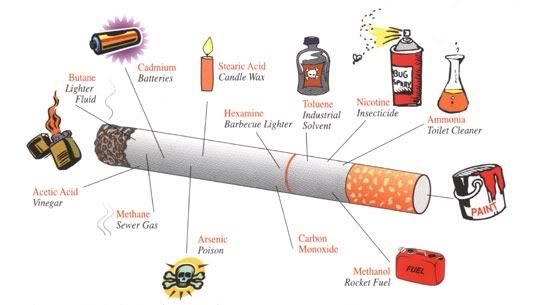
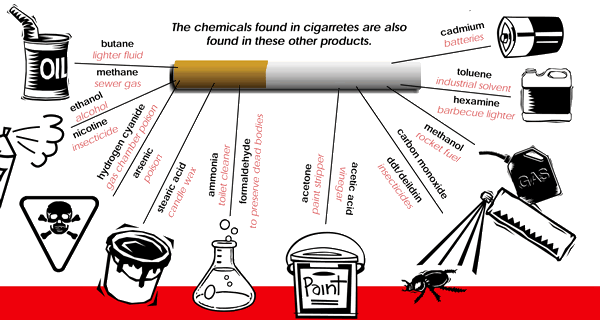
Cigarettes: a complex cocktail of chemicals
http://news.bbc.co.uk/1/hi/health/background_briefings/smoking/281167.stm
Smoking a cigarette is one of the most unhealthy things a human can do.
Cigarette smoke has been directly linked to an increased risk of many diseases including cancer, heart disease and even sexual impotence.
Nicotine constricts the blood vessels, raising blood pressure and increasing the strain on the heart.
Thirty per cent of all cancer deaths can be attributed to smoking. Cancers other than lung cancer which are linked to smoking include:
Cervical cancer
Cancers of the mouth, lip and throat
Pancreatic cancer
Bladder cancer
Kidney cancer
Stomach cancer
Liver cancer
Leukaemia
But cigarettes are not just made of tar, tobacco and nicotine.
More than 600 additives can legally be added to tobacco products.
These include coffee extract, sugar, vanilla, cocoa, menthol, oil from clove stems, caramel and chorophyll, the compound that gives plants their green colour.
Many appear to be present simply to add flavour.
But they may also have more sinister effects. For example, cocoa when burned in a cigarette produces bromine gas that dilates the airways of the lung, and increases the body's ability to absorb nicotine.
Menthol is also suspected of enabling the smoker to inhale more easily by numbing the throat.
Researchers claim that other additives have been expertly developed by tobacco companies to manipulate the delivery of nicotine with extreme precision.
Techniques employed by tobacco companies include:
Addition of ammonia compounds, which speed the delivery of nicotine to smokers by raising the alkalinity of tobacco smoke. These compounds also distort the measurement of tar in cigarettes, giving lower readings than would actually be inhaled by the smoker;
Addition of chemicals, such as acetaldehyde and pyridine, that act to strengthen nicotine's impact on the brain and central nervous system.
There is also concern about the so-called "burn enhancers" that cause cigarettes to remain ignited and may lead to additional fire hazards.
The tobacco companies have also developed ways to increase the nicotine content of cigarettes. These include:
Adjustment of tobacco blends by using high-nicotine tobaccos and higher nicotine parts of tobacco leaves to raise the nicotine concentration in lower tar cigarettes;
Addition of nicotine to fortify tobacco stems, scraps and other waste materials, which are processed into reconstituted tobacco - a product that is used in signficant quantities in most major cigarette brands;
The genetic engineering of tobacco plants to substantially boost nicotine content.
Other additives may cause harm by increasing the use of tobacco.
For example, sweeteners such as sugar can also be added to cigarettes, making them more appealing to young people.
A spokeswoman for the UK charity Action on Smoking and Health said: "The problem with additives is that they are not just about altering the flavour of cigarettes. Research has shown that the key purpose of putting extra additives into cigarettes is to improve their potency and ultimately their addictiveness.
"It is incredible that the tobacco industry has been allowed to get away with puting these compounds into their cigarettes without any requirement to say what they are there for."
The tobacco manufacturers argue that no compounds can be added to cigarettes without government approval, and agreed levels cannot be increased without permission.
Andrew J. Smiley, Esq. talks about college smoking ban
Smoking bans are public policies, including legal prohibitions and occupational safety and health regulations, that restrict tobacco smoking in workplaces and public spaces.
http://en.wikipedia.org/wiki/Smoking_ban
List of smoking bans
http://en.wikipedia.org/wiki/List_of_smoking_bans

Are you Ready for the new Smoking Ban?
http://www.itabmk.com/eNewsnosmokingban.aspx
A near total indoor smoking ban in England takes effect on 1 July 2007 – are you prepared? Smoking will be banned in all restaurants, pubs and clubs in England that serve hot food as well as public buildings like offices. A similar ban goes into effect in Wales on 2 April 2007. Scotland and Northern Ireland already have indoor smoking bans in place.
Smoking Ban Forces Bar Owners To Seek Creative Revenue Generators
http://www.kptv.com/news/13694958/detail.html
Gov. Ted Kulongoski has signed a bill to ban smoking in Oregon bars as of Jan. 2006 and local bar owners are searching for creative ways to keep their cash flow coming in.
In June, the Oregon House approved a bill to ban smoking in bars, taverns and bingo halls beginning January 2009. Those venues were originally exempted when Oregon banned workplace smoking in 1981.
The new measure would leave only cigar bars and smoke shops exempt. Hotels would be allowed to keep up to 25 percent of their rooms for smokers.
Supporters said 800 Oregonians a year die as a result of secondhand smoke, and the bill would save lives and reduce health care costs.
“I guess it’d be fine. Actually, I was kind of looking forward to when it happened because it would make me quit,” said Bill Hetzler.
Opponents of the ban said outlawing smoking in bars and restaurants would reduce revenue from the state lottery and could hurt business.
“If they are going to cut smoking out of all the bars, then I’m definitely going to go to a bar that allows me to smoke in a designated area and still have my cocktail with me,” said Lizz Kuchel.
Many cigarette companies, including Camel, is talking about converting parts of big outdoor patios into open-air tobacco dens, with the companies footing the bill.
Patios are considered fair game because the new ban only prohibits smoking 10 feet from doors, windows and ventilation.
No smoking news in bedford
The Night of the DC Smoking Ban

Bans Leave Smokers Fuming
Group Calls It Discrimination
http://www.cbsnews.com/stories/2005/02/22/earlyshow/contributors/tracysmith/main675552.shtml
Banning smoking is one of the hottest legislative issues today in states from Vermont to North Dakota.
While the bans may improve public health, they're leaving a lot of smokers out in the cold, reports The Early Show correspondent Tracy Smith.
You might say we've come a long way, baby -- but not everyone thinks we're moving in the right direction. As more and more bans take effect, smokers are being driven to the fringes of polite society, and that has many fuming.
Such as Audrey Silk, who says she's the target of a hate crusade.
"I'm now in constant defensive mode," she says.
Silk, a writer and ex-cop, is also a smoker.
"The general attitude is that smokers are lepers, and pariahs," Silk says. "Smokers are getting assaulted on the street, because they feel they've been given the green light."
Asked if she feels victimized, Silk blows out smoke and says, "Absolutely."
The anti-smoking movement is rapidly gaining ground.
"Welcome to the ashtray of the Northeast!" protesters chant. "Help keep Jersey cancer free!"
Seven states now ban smoking in all workplaces, including bars and restaurants. Three other states, including New Jersey, have bills pending.
Cigarette smokers, who once found some refuge in bars and smoking sections, are finding themselves out in the street, huddled in the cold, lighting up -- alone.
Silk notes, "In the United States of America, this is not the way it's supposed to be. You're not supposed to legislate people's behavior, and work to socially engineer them because you said so."
In Michigan, the CEO of health plan provider Weyco fired four employees for smoking, even while off the job, claiming rising health care costs were choking his business.
"This creates discrimination," Silk says. "This one steps over the line, because it's really a bigger threat."
Fed up with what she calls anti-smoker propaganda, Silk formed "New York City C.L.A.S.H.," a smokers' rights group.
The worst experience smoker Lynn Ryan-Loeb has had, she says, is having someone come right up to her face and lecture her about smoking.
Joseph Dobrian says, "I think it has become almost fashionable, almost chic, to bug smokers. I mean, you would not dream, or any polite person dream of going up to a total stranger and saying, 'Hey, fatso, lose some weight,' or 'God, get that ugly mole taken off your face.'"
Smoker Bob Martin urges, "Don't protect me from myself. If I want to smoke, allow me to smoke."
But Patrick Reynolds of TobaccoFree.org points out, "The rights of nonsmokers who may be standing nearby supersede the rights of smokers."
Reynolds is the grandson of tobacco man R.J. Reynolds, and he became an anti-smoking advocate after watching his father die of emphysema.
"Why should a nonsmoker have to breath -– involuntarily -- poisonous air?" Reynolds asks.
A tolerant public turned against smokers when numerous studies linked secondhand smoke to disease. According to the American Cancer Society, over 60,000 deaths each year are caused by secondhand smoke.
But Silk's group says the secondhand smoke argument can't be proven.
Silk says, "There are no bodies. They believe this is how many would be killed, but try to find a death certificate with that as a cause of death."
Reynolds scoffs at that: "Second hand smoke kills. It's time to get your head out of the sand."
Some smokers view the bans as positive, an impetus to quit. Not Silk's group. To them, lighting up is a right, no matter what the cost.
"Its our bodies," Lynn Ryan-Loeb says. "Our choice. We want to smoke. We don't need you policing us; we don't need you telling us what is good for us, and what you perceive is not good for us. And that's just the way it is."
Kissing and smoking
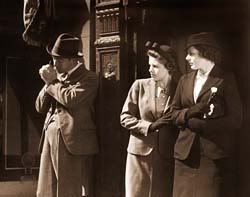
If Cigarettes Affect Movie Ratings, Will Hollywood Change?
Parents' Concerns About Onscreen Smoking May Motivate Changes in the MPAA's Rating System
http://abcnews.go.com/Business/story?id=2958260
The Motion Picture Association of America this week hinted that onscreen smoking may become a factor in the rating decisions for newly released movies.
This could signal a major shift in an industry in which Hollywood stars have long glamorized cigarettes and cigarette smoking.
The MPAA's ratings, which range from G to NC-17, have long been a source of controversy for movie studios, directors and audiences.
Last year's "This Film Has Not Yet Been Rated" revealed the often obscure methods by which movies are rated.
It has long been public knowledge that major studios work to secure favorable ratings for summer blockbusters so that they reach as large an audience as possible. Box-office sales often follow directly from there.
Public pressure may have something to do with the MPAA's change of direction.
A recent survey funded by the American Medical Association highlighted concerns about the effect of seeing famous actors light up. More than 80 percent of adults "agree that smoking in movies influences teens to smoke," according to the survey, which was conducted over three years by Mississippi State University's Social Science Research Center.
Furthermore, of the more than 6,000 adult survey respondents, 70 percent called for R-ratings in movies that show smoking, unless the film clearly demonstrates the dangers of smoking, or smoking is required for the authentic portrayal of a historical figure.
The MPAA's President Dan Glickman addressed this issue in a speech to industry executives in Las Vegas this past Tuesday. "For some time we have recognized that teen smoking is a major concern for parents," he said, adding, "we want to ensure that our ratings keep these concerns appropriately in mind and are updated as necessary."
Though the MPAA would not say when any concrete change to ratings criteria might take effect, some prominent anti-tobacco campaigners believe that a move to slap a higher rating on movies that contain smoking cannot come too soon.
"The simple act of having an R-rating for smoking in the movies, something that would cost absolutely nothing, would cut the exposure kids get to smoking in half and prevent about 200,000 kids a year from starting to smoke," said Stanton Glantz, who heads the Center for Tobacco Control, Research and Education at the University of California at San Francisco. Glantz recently started the movement "SmokefreeMovies."
According to many health professionals, the cause and effect relationship between the public marketing of cigarettes and their addictive properties is growing increasingly clear.
"If you look at the science, nicotine is a moderately enforcing drug," explains Dr. David Kessler, who was FDA commissioner from 1990 to 1997.
"But add to it other stimuli, add to it other cues, add to it other imagery, and what you end up with is a very powerfully addicting substance," said Kessler. "Put it in the movies, put it in the magazines, have it associated with high fashion, and you will see that its addictive properties only increase."
But some groups believe that such a measure, while not creating any First Amendment conflict, would certainly have some effect on artistic freedom.
"This increased number of content categories that the movie industry itself acknowledges may itself be cause for concern," said David Green of the First Amendment Center in Oakland, Calif. "The movie ratings system is voluntary, and this doesn't raise the prospect of government control. It only serves to embolden would-be censors."
Product placement has long been common in Tinseltown, and in the past, cigarettes were no exception. One of the best-known examples was the contract signed by Philip Morris and the producers of "Superman II," starring Christopher Reeve, which repeatedly featured the Marlboro cigarette brand on vans and taxis, while the character Lois Lane was often seen smoking, though her character never smoked in the first "Superman" film nor in any of the comic books.
But in recent years some of Hollywood's biggest players have begun siding with anti-tobacco campaigners.
Late last year, producer Harvey Weinstein decided that educational anti-smoking PSAs would appear before movie titles he released on DVD, including "School for Scoundrels" and "Clerks II."
The PSAs are intended to highlight the dangers of smoking for young people, a move Weinstein said at the time was "the right thing to do."
So while smoking role models remain on celluloid for now, it may be just a matter of time before those with star power start to think twice.

Steve McQueen Cigarette Ad

Smoking Will Play Role In Movie Ratings
MPAA Says Tobacco Use Could Lead To A More Adult Rating
http://www.cbsnews.com/stories/2007/05/11/entertainment/main2789533.shtml
Smoking will be a bigger factor in determining film ratings, the Motion Picture Association of America said Thursday, but critics said the move does not go far enough to discourage teens from taking up the habit.
MPAA Chairman Dan Glickman said his group's ratings board, which previously had considered underage smoking in assigning film ratings, now will take into account smoking by adults, as well.
That adds smoking to a list of such factors as sex, violence and language in determining the MPAA's G, PG, PG-13, R and NC-17 ratings.
Film raters will consider the pervasiveness of tobacco use, whether it glamorizes smoking and the context in which smoking appears, as in movies set in the past when smoking was more common.
Some critics of Hollywood's depictions of tobacco in films have urged that movies that show smoking be assigned an R rating, which would restrict those younger than 17 from seeing them.
"I'm glad it's finally an issue they're taking up, but what they're proposing does not go far enough and is not going to make a difference," said Kori Titus, spokeswoman for Breathe California, which opposes film images of tobacco use that might encourage young people to start smoking.
Glickman said a mandatory R rating for smoking would not "further the specific goal of providing information to parents on this issue."
Smoking in movies with a G, PG or PG-13 rating has been on the decline, and the "percentage of films that included even a fleeting glimpse of smoking" declined from 60 percent to 52 percent between July 2004 and July 2006," Glickman said.
Of those films, three-fourths received an R rating for other reasons, he said.
"That means there's not a great amount of films in the unrestricted category as it stands," said Joan Graves, who heads the ratings board. "We're not saying we're ignoring the issue. We're trying the best way possible according to what we've learned from parents to give them information about what's in a film."
Titus said smoking in films had declined in recent years but remains more prevalent than MPAA figures indicate.
Descriptions on sex, violence and language that accompany movie ratings now will include such phrases as "glamorized smoking" or "pervasive smoking," Glickman said.
If rated today, a film such as 2005's "Good Night, and Good Luck," about chain-smoking newsman Edward R. Murrow, would have carried a "pervasive smoking" tag but probably would have retained its PG rating because of its historical context in the 1950s, Graves said.
Titus said film raters should be as tough on smoking as they are on bad language to minimize the effects of on-screen smoking on children, including her own 5-year-old daughter.
"I don't want her using that language, but last time I checked, she's probably not going to die from that," Titus said. "If she starts smoking from these images she sees in movies, chances are she's probably going to die early from that."
While Titus' group wants tougher ratings restrictions, the MPAA released statements of support for its plan from John Seffrin, chief executive officer of the American Cancer Society, U.S. Sen. Joe Biden and filmmaker Rob Reiner, among others.
"By placing smoking on a par with considerations of violence and sex, the rating board has acknowledged the public-health dangers to children associated with glamorized images of a toxic and lethal addiction to tobacco," Barry Bloom, dean of the Harvard School of Public Health, said in a statement.

The biggest myths about stopping smoking
http://www.nosmokingday.org.uk/smokers/realtruth.htm
Are there any benefits to smoking?
It has been argued that smoking does have some benefits. The most common benefits that people believe are that smoking is good for stress relief, weight control and increased concentration.
Smoking helps me relieve stress
One of the most common reasons people give for continuing to smoke or for going back to smoking after stopping is to relieve stress. The reality is that smokers tend to report higher levels of stress than non-smokers. After stopping smoking the level of stress in former smokers drops significantly. When you stop smoking it may feel like you are more stressed as a result of not smoking. For the first few weeks you are likely to experience mood swings and be irritable. The nicotine in cigarettes is highly addictive and these are symptoms of withdrawal. You can help manage these by using a Nicotine Replacement Therapy (NRT). These symptoms normally last up to four weeks.
Smoking helps me stay thin
On average, smokers do weigh less than non-smokers. When you stop smoking the typical weight gain is around 2-3 kg. The nicotine from smoking acts as an appetite suppressant and smoking also increases the rate at which your body burns calories. Smokers will often replace cigarettes with snacking when stopping smoking. People often believe that smoking will help them to control their weight and be healthier. However the risks of continuing to smoke far outweigh those from minor weight gain. The charity Quit have an exercise programme for smokers who want to stop smoking.
Does smoking help protect me against Alzheimers?
It has been suggested that smoking can help reduce the risk of Alzheimer’s disease. However this has been largely dismissed by experts and the evidence is now suggesting that smoking increases your risk of dementia. More information can be found from the Alzheimers Society.
Can using Nicotine Patches hurt my baby if I am pregnant?
There is currently not enough evidence to suggest that using patches can be of significant harm to your baby. However, before you use any NRT you should consult your doctor. You might be better off using one of the shorter term nicotine replacement products such as gum or lozenges. Remember that the most harm to your baby is caused by smoking during pregnancy. NRT does not contain the 4000 chemicals that you can pass onto to your baby from smoking. Talk to your GP before you start using any stop smoking medicines.s.
Can I benefit my health by changing the way I smoke?
Is it better for me to switch to light, mild or low tar cigarettes?
We all know which cigarette packs are supposed to be light or mild, even if it no longer says on the packet. For years smokers have seen these products as a ‘healthier’ alternative to smoking ‘full strength’ cigarettes. Research shows that smokers of 'light' or 'mild' brands are likely to inhale as much tar and nicotine as smokers of regular cigarettes. This means they can take in as many cancer-causing poisons as smokers of regular cigarettes. In simple terms, 'low tar' cigarettes are just as harmful as regular cigarettes.
Is cutting down a good idea?
Many people believe that cutting down is a good way to reduce the health risk from smoking. This might include smoking fewer cigarettes, switching to lower strength brands or switching to alternatives to cigarettes such as roll ups or cigars. There is evidence to show that when people smoke fewer cigarettes they tend to smoke them harder to compensate for smoking fewer meaning that there is no real health benefit. There is no evidence that merely cutting down as a strategy to stop makes a quit attempt more likely to succeed. The only way to really reduce the risks from smoking is to stop completely. If you cannot stop smoking totally an option is to use Nicotine Replacement Therapy whilst cutting down.
Just one won’t hurt…
It is very easy to get tempted into having just one cigarette once you have stop. DON’T DO IT. This is one of the easiest ways to get back into smoking. If you really are desperate for ‘just one’ you should consider avoiding the places and situations where you find temptation. It may also help to use Nicotine Replacement Therapy to manage the cravings until you feel in control of the temptations.
What if I get addicted to Nicotine Replacement Therapy?
It is extremely unlikely that you will become addicted to using NRT instead of cigarettes. The dose of nicotine is smaller and more controlled. Unlike cigarettes which deliver nicotine in an immediate and high dose, delivery from NRT is much slower and more controlled. The level of immediate satisfaction is not the same. This helps to control the addiction to cigarettes whilst allowing you to wean yourself off nicotine. Nicotine in NRT is safe to use unlike nicotine in cigarettes as it does not contain the 4000 harmful chemicals found in cigarette smoke. Even if you end up using NRT for a long time, there is very little risk.
My Gran is 90 yrs old and smoked all her life…
There is always the story about the 103 year old whose secret to long life is 20 cigs a day and a tot of brandy before bed. Chances are that their long life has absolutely nothing to do with smoking. The fact is that half of all smokers will die as a result of smoking. Of the other half, some might live to extreme old age but you are far more likely to live longer if you don’t smoke. Even if you are lucky enough to escape fatal illness, smoking still increases signs of ageing, chances of impotence and blindness and a whole range of nasty ailments that could make your golden years very unpleasant.
It can’t hurt me now, I’m only young
The younger you stop smoking, the more chance you have to benefit later. After stopping smoking it can take 15 years to totally reduce your risk of heart attack to that of a non-smoker so the sooner you stop the more chance you have of reclaiming benefits over time. For a list of all the benefits of stopping over time see our ‘benefits of stopping’ page.
Roll ups, Cigars and Pipes are OK?
Some people think that changing to a roll-up cigarette can help them to stop smoking, or to reduce the harmful effects of smoking. Evidence suggests that smoking roll ups is actually more dangerous. Roll ups burn at a higher temperature than manufactured cigarettes. They also go out more, requiring re-lighting. These factors mean that you are getting higher doses of harmful smoke each time you inhale. Major studies of pipe and cigar smokers have shown that cigar smokers have double the risk of lung cancer than non-smokers. Pipe smokers increase the risk of lung cancer to eight times that of non-smokers. However you smoke your risk of fatal disease is significantly higher than as a non-smoker.

Smoke Alarm: The Truth About Smoking And Mental Illness
http://www.medicalnewstoday.com/articles/66900.php
Nearly 70 percent of individuals with serious mental illness (SMI), as compared with 23 percent of the general population, smoke cigarettes. Smokers with SMI and addiction consume nearly half of all cigarettes sold in the United States. Individuals with SMI are more than twice as likely to develop cardiovascular disease, over three times as likely to develop respiratory disease and cancer, and have a life expectancy that is twenty-five years shorter than the general population. However, smokers with SMI have less access to cessation services and traditional treatments are less effective on this population.
A project conducted by healthcare professionals at Clubhouse of Suffolk, Inc., a private, not-for-profit, psychiatric rehabilitation agency in New York, has found compelling evidence that these individuals respond to tailored interventions which address their specific needs. The project, which consisted of 57 Clubhouse members over the duration of one year, was funded by the New York State Department of Health, Tobacco Control Program.
In October 2003, Clubhouse was awarded a grant to address the special needs of patients who struggle with tobacco addiction. The Clubhouse Project reveals that even a small reduction in smoking in this population will demonstrate favorable health outcomes as well as a cost-savings to State Medicaid expenditures. The findings were documented in a video, "Smoke Alarm: The Truth about Smoking and Mental Illness."
In a pilot study, this model which included staff development/training, individual and group psycho-educational treatment and coordination of pharmacological treatment, had a significant impact on the readiness of participants to quit smoking, the number of cigarettes smoked per day (6.8cpd reduction), and the number of participants who made a quit attempt (36%).
The Smoking Cessation Project at Clubhouse addressed the unique issues of tobacco use within this population and outlines the model which was developed and applied: a comprehensive approach addressing the biological, psychological and social aspects of tobacco dependence in individuals with mental illness.
Initial plans for smoking cessation included assessing all members for tobacco use, developing strategies for working with smokers less motivated to quit, and providing action-oriented treatment for those ready to quit. The team spearheading the program developed health fairs and educational events for Clubhouse members.
An eight-session wellness curriculum was implemented that covered nutrition, exercise, and information about tobacco. This strategy increased the involvement of smokers less motivated to quit and also linked smoking cessation to other activities promoting healthy lifestyles. Many members graduated from the wellness curriculum into smoking cessation classes, creating a continuum of services.
In the summer of 2004, nine months after the program started, Clubhouse members (both smokers and non-smokers) decided to restrict outdoor smoking to certain areas and to prohibit smoking near the entrances pf the building. Two peer leaders who had been smoke free for at least six months were hired to supplement program staff efforts. They provided additional support to members who had recently quit smoking through daily phone calls and support groups.
The program staff facilitated tobacco cessation groups that were held twice a week for eight-week cycles that repeated continuously for more than a year. Members benefited from education, ongoing support and additional individual counseling sessions. Staff helped clubhouse members access tobacco treatment medications from off-site psychiatrists and primary care physicians. Clubhouse members who used pharmacotherapy were more successful in quitting.
This project also sought to reshape the culture of nearby mental health facilities. A tobacco advisory board with clubhouse administrative staff, key stakeholders, and local community providers was developed. The board was essential in helping identify and resolve potential barriers to program implementation.
The healthcare professionals that created the Smoking Cessation Project at Clubhouse include:
Jill Williams, M.D., is an Associate Professor of Psychiatry and Director of Mental Health Tobacco Services at the UMDNJ-Robert Wood Johnson Medical School. Dr. Williams specializes in the treatment of tobacco dependence in mentally ill populations.
Bernadette W. Cain, M.B. A., the Project Director of the Smoking Cessation Project of Clubhouse of Suffolk. She is currently the Training Director of the Tobacco and Mental Health Training Project funded by NYS, DOH, Tobacco Control Program (TCP).
Mary O'Shaughnessy, Psy.D, N.P.P., is a Psychiatric Nurse Practitioner and Professor of Nursing at Molloy College in New York.
Tara Fredericks, LMSW, Clinical Coordinator of the Smoking Cessation Program, is currently the Project Director of Tobacco and Mental Health Training Project.
Newport Cigarettes 1967 TV commercial
Tobacco Industry's Targeting of Youth, Minorities and Women
http://www.americanheart.org/presenter.jhtml?identifier=11226
The American Heart Association supports legislation that seeks to restrict or prohibit tobacco advertising, promotion and marketing to young people, minorities or women. The American Heart Association also works in partnership with the National Center for Tobacco-Free Kids on this important issue.
How does the tobacco industry target youth?
The tobacco industry has long targeted young people with its cigarette advertising and promotional campaigns. One of the most memorable, the now-defunct “Joe Camel” campaign initiated by the R.J. Reynolds Tobacco Company, helped generate public outrage against tobacco company efforts to reach young audiences. In the November 1998 multistate tobacco settlement, the major tobacco companies promised not to “take any action, directly or indirectly, to target youth … in the advertising, promotion, or marketing of tobacco products.” But studies since then have shown that tobacco-industry marketing has reached record levels since the settlement, with much of the increase due to strategies aimed at young people.
In 1999, the first year after the multistate settlement agreement (MSA), the tobacco companies spent a record $8.4 billion on advertising and promotions, an increase of 22.3 percent from the previous year, the largest one-year increase since the U.S. Federal Trade Commission began tracking tobacco industry marketing expenditures in 1970. Then, in 2000, they increased expenditures another 14 percent to $9.6 billion. In 2001, the major tobacco companies increased their marketing expenditures to more than $11.4 billion, an increase in tobacco industry marketing of more than 66 percent since 1998. An August 2001 study in the New England Journal of Medicine showed that cigarette companies increased their advertising in youth-oriented magazines after the MSA was signed, especially for the three brands most popular with youth – Marlboro, Camel and Newport.
The National Survey on Drug Use and Health estimates that each day more than 4,000 people under 18 try their first cigarette. That's more than 730,000 new smokers every year. According to the Final Report of the National Commission on Drug-Free Schools, children and adolescents consume more than one billion packs of cigarettes a year. Economist Kenneth Warner, Ph.D., estimates that the tobacco industry needs to recruit 5,000 new young smokers every day to maintain the total number of smokers (due to the number of people who quit or die from tobacco-related illness each year). The Department of Health and Human Services estimates that 90 percent of smokers begin tobacco use before age 20; 50 percent of smokers begin tobacco use by age 14; and 25 percent begin their smoking addiction by age 12 (the 6th grade). Since 1991, past-month smoking has increased by 35 percent among eighth graders and 43 percent among 10th graders, while smoking among high school seniors is at a 19-year high. An April 1996 Journal of Marketing study concluded that children are three times more sensitive to advertising. According to a 1994 Centers for Disease Control report, 86 percent of underage smokers prefer Marlboro, Newport or Camel, the three most heavily advertised cigarette brands.
How does the tobacco industry target minorities?
During the last decade, the tobacco industry has aggressively increased its advertising and promotional campaigns targeted at minorities. One of the industry's most notorious, and ultimately failed, minority cigarette marketing campaigns was for "Uptown" cigarettes. The American Heart Association, the American Cancer Society and the American Lung Association, working jointly as the Coalition on Smoking OR Health, played an active role in the Philadelphia "Coalition Against Uptown Cigarettes." The coalition brought health, consumer and social justice groups together to oppose the test marketing of Uptown in Philadelphia. R.J. Reynolds Tobacco Co., the manufacturers of Uptown, eventually withdrew the product under pressure from the coalition and HHS Secretary Louis Sullivan, MD. In addressing the issue of tobacco industry targeting of minorities, Dr. Sullivan said: "At a time when our people desperately need the message of health promotion, the tobacco industry's message is more disease, more suffering and more death for a group already bearing more than its share of smoking-related illnesses and mortality." Former District of Columbia Health Commissioner Reed Tuckson defined the tobacco industry's marketing practices as "the subjugation of people of color through disease." Recent studies have shown a higher concentration of tobacco advertising in magazines aimed at African Americans, such as Jet and Ebony, than in similar magazines aimed at broader audiences, such as Time and People. According to the Centers for Disease Control, in 1996 smoking rates among African-American males had doubled within four years. From 1992 to 2000 smoking rates increased among African-American 8th graders from 5.3 percent to 9.6 percent; among African-American 10th graders from 6.6 percent to 11.1 percent, and among African-American 12th graders from 8.7 percent to 14.3 percent. Although African Americans tend to smoke fewer cigarettes per day and begin smoking later in life than whites, their smoking-related disease mortality is significantly higher.
Black-owned and black-oriented magazines receive proportionately more revenues from cigarette advertising than do other consumer magazines. In addition, stronger, mentholated brands are more commonly advertised in black-oriented than in white-oriented magazines. Billboards advertising tobacco products are placed in African-American communities four to five times more often than in white communities.
According to the National Coalition of Hispanic Health and Human Services Organizations, the tobacco industry specifically targets Hispanic consumers because of the long-recognized "economic value of targeting advertising to low-income Hispanics and non-Hispanic blacks," and because "Hispanics tend to be much more 'brand-loyal' than their non-Hispanic white counterparts." The Hispanic coalition also concluded "Billboards and posters targeting (the) cigarette message to Hispanics have spotted the landscape and store windows in Hispanic communities for many years, especially in low-income communities... Recent innovations have included sponsorship of community-based events such as festivals and annual fairs."
How does the tobacco industry target women?
More than 178,000 women die every year from smoking-related diseases. Smoking among girls and young women increased dramatically during the 1990s. From 1991 to 1999, smoking among high school girls increased from 27 to 34.9 percent. Lung cancer has become the leading cause of cancer death among women, having increased by nearly 400 percent in the past 20 years. That statistic led former U.S. Surgeon General Antonia Novello to comment that "the Virginia Slims Woman is catching up to the Marlboro Man."
Ironically, since the 1980 Surgeon General's Report on women and smoking, the tobacco industry has stepped up the introduction of cigarette brands targeted to women. The new wave of marketing to women includes cigarettes advertised for their perfumed scents and exotic flavors or whose names include the terms "slims" and "lights." Product packaging and advertising have also featured watercolors and pastels.
One of the most egregious examples of the tobacco industry's targeting of women was the introduction of "Dakota" by R.J. Reynolds in 1990. An internal Reynolds marketing plan revealed that Dakota was to be marketed to "virile females" between the ages of 18 and 24 who have no education beyond high school and who watch soap operas and attend tractor pulls. At a 1990 Interagency Committee on Smoking and Health meeting chaired by the Surgeon General, the Dakota marketing plan was called a "deliberate focus on young women of low socioeconomic status who are at high risk of pregnancy." The target market for Dakota also happens to be the one group of women where smoking rates have declined the least and who are more likely than other women to continue to smoke during pregnancy. Cigarette companies continue to target women using themes in advertising that associate smoking with independence, stylishness, weight control, sophistication and power.
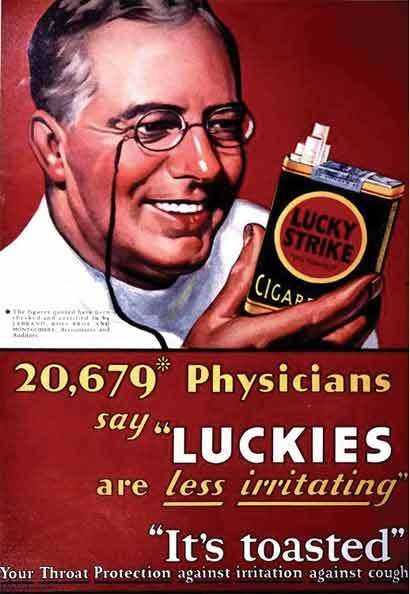
More Doctors Smoke Camels Than Any Other Cigarette

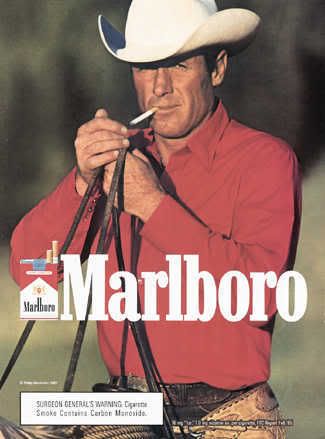
Marlboro Commercial

Classic 1970/71 Camel Filters Cigarettes Commercial
50's Cigarette Ad
Newport Cigarette Commercial
Flinstones Cigarette Ad

Chesterfield cigarettes preferred by professional smokers!?
Like Father Like Son
Marlboro 01
The last cigarette














![Brotherhood" (2006) [TV-Series]](http://photos1.blogger.com/x/blogger2/1421/379621144723082/211/z/425926/gse_multipart33129.jpg)







No comments:
Post a Comment